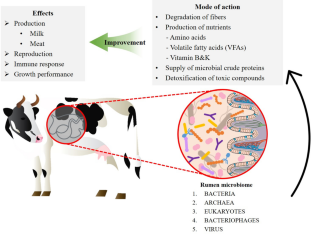Journal of Microbiology ( IF 3 ) Pub Date : 2024-04-25 , DOI: 10.1007/s12275-024-00121-4 Gi Beom Keum , Sriniwas Pandey , Eun Sol Kim , Hyunok Doo , Jinok Kwak , Sumin Ryu , Yejin Choi , Juyoun Kang , Sheena Kim , Hyeun Bum Kim

|
The importance of ruminal microbiota in ruminants is emphasized, not only as a special symbiotic relationship with ruminants but also as an interactive and dynamic ecosystem established by the metabolites of various rumen microorganisms. Rumen microbial community is essential for life maintenance and production as they help decompose and utilize fiber that is difficult to digest, supplying about 70% of the energy needed by the host and 60–85% of the amino acids that reach the small intestine. Bacteria are the most abundant in the rumen, but protozoa, which are relatively large, account for 40–50% of the total microorganisms. However, the composition of these ruminal microbiota is not conserved or constant throughout life and is greatly influenced by the host. It is known that the initial colonization of calves immediately after birth is mainly influenced by the mother, and later changes depending on various factors such as diet, age, gender and breed. The initial rumen microbial community contains aerobic and facultative anaerobic bacteria due to the presence of oxygen, but as age increases, a hypoxic environment is created inside the rumen, and anaerobic bacteria become dominant in the rumen microbial community. As calves grow, taxonomic diversity increases, especially as they begin to consume solid food. Understanding the factors affecting the rumen microbial community and their effects and changes can lead to the early development and stabilization of the microbial community through the control of rumen microorganisms, and is expected to ultimately help improve host productivity and efficiency.
中文翻译:

了解瘤胃微生物组的多样性和作用
强调了反刍动物中瘤胃微生物群的重要性,不仅作为与反刍动物的特殊共生关系,而且作为各种瘤胃微生物的代谢产物建立的相互作用和动态的生态系统。瘤胃微生物群落对于生命维持和生产至关重要,因为它们有助于分解和利用难以消化的纤维,提供宿主所需的约 70% 的能量和到达小肠的 60-85% 的氨基酸。瘤胃中细菌数量最多,但原生动物体型较大,占微生物总数的40%~50%。然而,这些瘤胃微生物群的组成在整个生命过程中并不保守或恒定,并且受宿主的影响很大。众所周知,犊牛刚出生后的最初定植主要受母亲的影响,随后会根据饮食、年龄、性别和品种等多种因素而发生变化。最初的瘤胃微生物群落因氧气的存在而含有需氧菌和兼性厌氧菌,但随着年龄的增长,瘤胃内形成缺氧环境,厌氧菌在瘤胃微生物群落中占主导地位。随着小牛的成长,分类多样性增加,特别是当它们开始食用固体食物时。了解影响瘤胃微生物群落的因素及其影响和变化,可以通过对瘤胃微生物的控制来实现微生物群落的早期发展和稳定,并有望最终有助于提高宿主的生产力和效率。



























 京公网安备 11010802027423号
京公网安备 11010802027423号